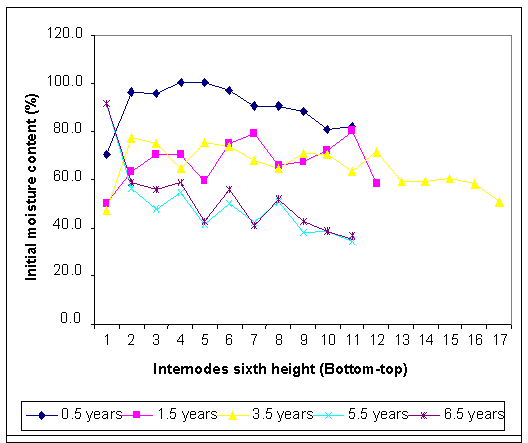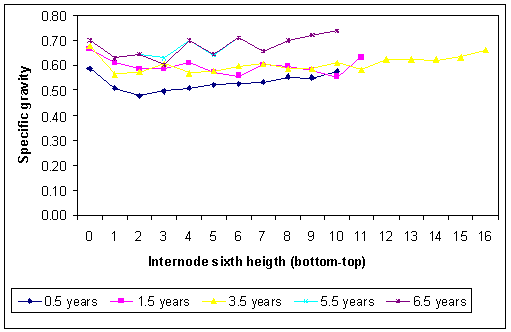

0030-B4
Norul Hisham Hamid & Abd. Latif Mohmod & Othman Sulaiman 1
The variation of initial moisture content and specific gravity in Gigantochloa scortechinii along the internodes sixth height were investigated. The culms were taken from the natural stand. This study found that the initial moisture content was decreased with the culms age and along the internodes sixth height. Nevertheless, the specific gravity gave an opposite result.
The initial moisture content and specific gravity of bamboo have a significant role in setting the processing line and equipments of the specific bamboo products and production. The moisture content for example, would influence the dimension stability and further degraded the strength, stiffness, processing and durability (Brown et al., 1952; Panshin & de zeeuw, 1970; Grewal, 1978). Mean while, specific gravity is a total woody material per volume and always linked to the physical and mechanical properties. Both factors were among the indicator in ruling the product segmentation of bamboo from specific culms age.
Consequently, there are many research have been conducted on both moisture content and specific gravity intensively, and the information gathered is well established. However, the investigation on the scenario of both factors along the internodes height itself is still lacking. Hopefully, this study would lead a better understanding and knowledge in utilizing and processing of bamboo products with special reference to the whole internodes uses.
Gigantochloa scortechinii with five different age classes namely 0.5, 1.5, 3.5, 5.5, and 6.5 years old from natural stand Nami, Kedah (northern part of Peninsular Malaysia) were selected. Age of the culms was marking starting the first day of their shooting period. Those culms were taken within the same clump. Each culm from internodes sixth were cut and immediately coated with solvent based paint and kept inside the ice box before being transferred to the laboratory.
Each culms from internodes sixth were cut into 3 cm long from bottom part (numbering as ring no.1) up to top of the internodes sixth height (numbering as ring no.2, 3, 4.....n) using a hand saw. The rings were then cut in diameter of 1 cm width with a chisel to get a final size of the specimen 3 cm length X 1 cm width X culm wall thickness.
The initial weight of the specimens was determined with measuring device into two decimal places. All the unnecessary fibre and dust were removed before the reading were taken. This process was taken immediately to avoid air dried of the specimens.
The volume of the specimens was measured by a weight displacement method. The process was done by soaking the specimens into distilled water without touching the glass. The specimens were maintained in distilled water until all air bubble come out and the final reading was taken.
The specimens were oven dried at the temperature of 103±2 O C for 24 hours. Inside the oven, the specimens were arranged with distance 1 cm each others to allow even heat flow.
The Initial moisture content and specific gravity were calculated using the following formula:
Initial moisture content (%) = [(WI - WO)/WO] X 100
Specific gravity = WO/Vg
Where,
WI - Initial weight (g)
WO - Oven dried weight (g)
Vg - Volume of the specimens (cm 3 )
Regardless of age and internodes height, the initial moisture content and specific gravity varied from 48.6 % to 90.5 % and 0.53 to 0.68 respectively (Table 1). The initial moisture content found in this study differed significantly (P<0.01) with age, internodes height, and the interaction between age and internodes height (Table 2). These results however were differed from those of G. scortechinii reported by Abd. Latif & Mohd. Zin (1992) taken from the Forest Research Institute Malaysia (FRIM) trial plot.
Generally, Table 1 shows that the highest value of initial moisture content were observed in the 0.5 years old culms (90.5 %) while the lowest in 6.5 years old culms (48.6 %). The mean values also show significant decreased by age (r= -0.13). Abd. Latif & Mohd. Zin (1992) on their studies reported that the initial moisture content of bamboo culms were about 87.9 % (one year), 77.6 % (two years), and 69.1 % (three years) respectively. The swing pattern of the moisture content with age could be happened due to thickening process of fibre and parenchyma cells wall as young culms enter to the maturation stage. The variation that exist between both locations could probably best explained by the different harvesting time and climatic factors (Nami in northern region and FRIM in central region) as moisture content of the bamboo were tendency higher in rainy compared to dried season (Abd. Latif & Liese 1998).
| Table 1. Mean value of initial moisture content and specific gravity along the Internodes sixth height |
Age (years) |
Initial Moisture content (%) |
Specific gravity |
0.5 |
90.5 |
0.53 |
1.5 |
67.7 |
0.59 |
3.5 |
65.4 |
0.61 |
5.5 |
59.5 |
0.63 |
6.5 |
48.6 |
0.68 |
Within the internodes sixth height, the initial moisture content were found to be significantly decreased from bottom to the top portion of the internodes height (r= -0.13). This trend probably be due to the maturation process of the cells occurred along the internodes from top towards bottom portion (Itoh 1975, Itoh & Shimaji 1981, Itoh 1990). As this happened, the fiber and parenchyma cells wall most likely to be thicker along the internodes height itself.
From Figure 1, the initial moisture content along the internodes sixth height of culms aged 0.5 years old ranged between 70.2-121.3 %, 50.3-80.5 % from the 1.5 years old, 42.3-77.3 % from the 3.5 years old, 36.2-52.3 % from the 5.5 years old, and 36.4-68.5 % from the 6.5 years old culms respectively (Figure 2). The highest value was observed in the 0.5 years old culms (51.1 %) and the lowest in the 6.5 years old culm (16 %).

Figure 1. Variation of initial moisture content along internodes sixth height
Similar to that of the initial moisture content, the specific gravity was found to differ significantly (P<0.01) with the age, internodes height, and the interaction between age and internodes height of the culms (Table 2). The similar pattern was also observed by Abd. Latif et al. (1991) and Satar et al. (1991).
As the initial moisture content reduced, the specific gravity gave reverse results (Table 1). The highest specific gravity recorded was 0.68 (6.5 years old culm) and the lowest was 0.53 (0.5 years old culm). Generally, the mean values was significantly increase with age (r= 0.60).
The similar pattern was also observed by Abd. Latif & Mohd. Zin (1992). The increasing trend of the specific gravity with age could probably be due to the increment of fiber wall thickness and the decreasing of fiber lumen diameter as young culms reach the maturation stage. Other factor may probably be contributed by the increment of tangential diameter/radial length ratio of vascular bundles itself since the anatomical properties of bamboo are closely correlated to the culm wall thickness. (Grosser & Liese 1971, Abd. Latif & Mohd Tamizi 1992).
From Table 3, the specific gravity show significant increased (r=0.11) along the internodes sixth height from bottom up to the top portion. As stated earlier, the maturation process within the internodes height almost certainly contributes to the above factors. The increment of fiber and parenchyma wall thickness from bottom up to the top would probably increase the total volume of woody substance itself.
From Figure 2, the specific gravity along the internodes sixth height of culms aged 0.5 years old ranged between 0.51-0.59, 0.55-0.67 (1.5 years old), 0.56-0.68 (3.5 years old), 0.57-0.67 (5.5 years old), and 0.63-0.71 in the 6.5 years old culms (Figure 3). The highest value was observed in the 1.5 years old culm (0.12) and the lowest one in 0.5 and 6.5 years old culm (0.08) respectively.

Figure 2. Variation of specific gravity along the internodes sixth height
| Table 2. Result of ANOVA on initial moisture content and specific gravity along the Internodes sixth height |
Source of variation |
DF |
F value and statistical significance | |
Initial moisture content |
Specific gravity | ||
Main effect Age Internodes height Age X internodes height |
11 4 7 28 |
39.31 102.84*** 3.01** 2.81*** |
36.12 94.83*** 2.55** 2.39*** |
| ** - is significant different at P<0.05. *** - is significant different at P<0.001. |
| Table 3. Result of correlation test on initial moisture content and specific gravity along the internodes sixth height |
Variables |
Age |
Internodes height |
Initial Moisture content Specific gravity |
-0.23*** 0.60*** |
-0.13** 0.11** |
| ** - is significant different at P<0.05. *** - is significant different at P<0.001. |
Generally, it can be concluded that the initial moisture content of G. scortechinii significantly decreased with the increment of age and internodes height from bottom to the top portion. Since the initial moisture content reduced, the specific gravity gave an opposite results.
The author would like to thank Dr. Richard Murphy from Imperial College, London and Dr. Othman Sulaiman from Universiti Sains Malaysia for supervising this project. Thank you also to Dr. Abd. Latif Mohmod from FRIM for his critical view of this paper.
Abd. Latif, M., Wan Tarmeze, W.A. & Hamami, S. 1991. Variation of physical properties of two Malaysian Bamboo. Pp. 222-236 in Bamboo in the Asia Pacific. Proceedings 4 th International Bamboo Workshop's. 27-30 November 1991. Chiangmai.
Abd. Latif, M. & Mohd Tamizi, M. 1992. Variation of anatomical properties of three Malaysia bamboos from natural stand. Journal of Tropical Forest Sciences 5(1):90-96.
Abd. Latif, M. & Mohd. Zin, J. 1992. Trends of variation in some physical properties of Gigantochloa scortechinii. INBAR Information Centre, India Bulletin 2(2): 7-12.
Abd. Latif, M. & Liese, W. 1998. Influences of age, culm, height, site and harvesting month on moisture content level of two Malaysian bamboos. Paper presented at the VI International Bamboo Workshop and V International Bamboo Conferences. 2-6 November 1998. San Jose, Costa Rica.
Brown, H.P., Panshin, A.J. & Forsaith, C.C. 1952. Textbook of Wood Technology. 1 st edition. 785p.
Grewal, G.S. 1978. Kiln drying characteristics of some Malaysian timber. Malaysian Forest Service. Timber Trade Leaflets, No. 42. p.42.
Grosser, D. & Liese, W. 1971. On the anatomy of Asian bamboos with special references of their vascular bundles. Wood Science and Technology 5: 290-312.
Itoh, T. 1975. Application of freeze etching technique for investigating cell wall organization of parenchyma cell in higher plant. Wood Research. 58: 20-32.
Itoh, T. & Shimaji, K. 1981. Lignification of bamboo culm (Phyllostachys pubescens) during its growth and maturation. Pp. 104-110 in Higuechi, T. (ed) Bamboo Production and Utilization. Proceedings XVII IUFRO Congress Group, Kyoto, Japan.
Itoh, T. 1990. Lignification of bamboo (Phyllostachys heterocycla Miff.) during its growth. Holzforschung 44: 191-200.
Kellogg, R.M. 1991. Physical properties of wood. Pp. 195-223 in Wangaard, F.F (ed) Wood: its structure and properties (Waagaard, F.F., ed.). Vol 1. Clark C. Heritage memorial series on wood.
Liese, W. 1985. Bamboos-biology, silvics, properties, utilization. Schriftenreihe der GTZ No. 180. Pp. 63-80.
Panshin, A.J. & de Zeeuw, C. 1970. Textbook of wood technology. New York, McGraw Hill Book. Co. 1:237-258.
Satar, M.A., Kabur, M.F. & Bhattacharjee, D.K. 1991. Effect of age and height position of Muli (Melaconna baccifera) and Borak (Bambusa balcooa) Bamboo on their physical and mechanical properties. Pp. 182-187 in Bamboo in Asia pacific. Proceedings of the 4 th International Bamboo Workshop. 27-30 November 1991. Chiangmai.
Thomas, R.J. 1979. Wood anatomy and ultrastructure. Pp. 109-146 in Wangaard, F.F (ed.) Wood, its structure and properties Vol 1.
1 Norul Hisham Hamid & Abd. Latif Mohmod & Othman Sulaiman
Forest Product Technology Division, Forest Research Institute Malaysia (FRIM), Kepong, 52109 Kuala Lumpur, Malaysia
Tel: (603)-62797000 Ext: 7426
Fax: (603)-62797861
Email: [email protected]
Website: http://www.frim.gov.my